A little Bit of Michelson
Albert Michelson (1852–1931)
The most important measurement of zero originated in the Wild West of gold and silver mining. Literally, the Wild West.
Albert Michelson was born in Poland to Rosalie and Samuel Michelson, an itinerant merchant. Theirs was a mixed Jewish-Christian union and when Albert was three years old, they fled their country after the failed Greater Poland uprising of 1848 against the ruling Prussians. An intrepid band, this family. With toddler Albert and two younger (!) sisters, they made their way to Hamburg where they boarded a crowded steamer for the three week journey to New York, to live with one of Rosalie's relatives on the lower East Side. There they heard stories of the riches of the gold rush in California. Remarkably, Samuel's sister and her husband had emigrated and settled in Murphy's Camp 150 miles east of San Francisco to prospect for gold.
Samuel was not a miner, but he knew how to buy and sell merchandise and determined that what the thriving gold miners needed was...a dry goods store and after a couple of weeks in NYC off they went to California. But not in a normal way. They could have sailed around Cape Horn. They could have traveled across the country in covered wagons. Or, they could have taken the dangerous route:
The family boarded another steamer for Panama, then by canoe, mule train, and a brand new railway, made their way across the isthmus to a clipper ship and on to San Fransisco. It was a harrowing journey with a lack of water, danger from outlaws, and desperately sick natives all around them. It made an impression on Albert that he never forgot. The last leg of their journey was by stagecoach to Murphy's Camp in the foothills of the Sierra Nevada. After more than a year of unusual traveling, they settled alongside Samuel's brother-in-law and set up shop with the goods needed by any respectable prospector.
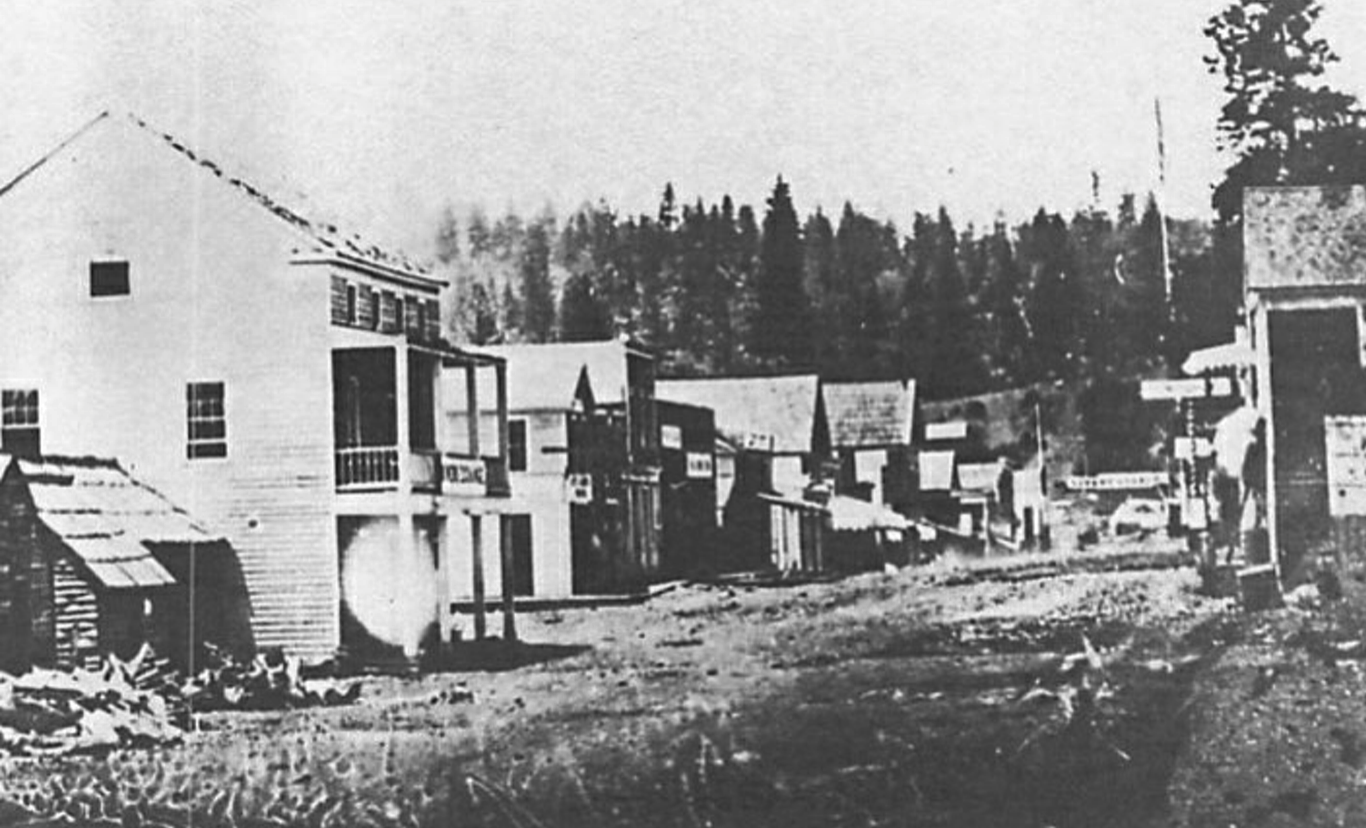
Murphy's Camp in 1852 (Kenneth M. Castro)
Murphy's was a prosperous mining town–literally tens of millions of dollars in gold was shipped out of that camp in a few years and so it was a thriving community, but one full of drunks, violence, public hangings, and hard edges. In 1857 Albert was sent to the Murphy school in its first year of operation. Things were going well until the entire town burned to the ground in 1859 in less than an hour. They rebuilt, better...with even an Opera House!
In 1864, Rosalie decided that Albert needed a more formal education. She had tutored him, even insisting on violin lessons, but since Samuel's family had gone back to San Francisco, Albert was sent with them, eventually attending the San Francisco Boys' High School where he so impressed the principal, that he was absorbed into his home and given special access to the school's science lab...and boxing lessons. By this time, Murphy's had declined to an unlivable condition. Gold had dried up and the family moved to Virginia City, Nevada...where silver was all the rage. Virginia City boasted 30,000 inhabitants and Samuel moved right in a large house with his store on the ground floor, and residence above. The family and the business flourished, but Albert needed a different path. A scientific one.
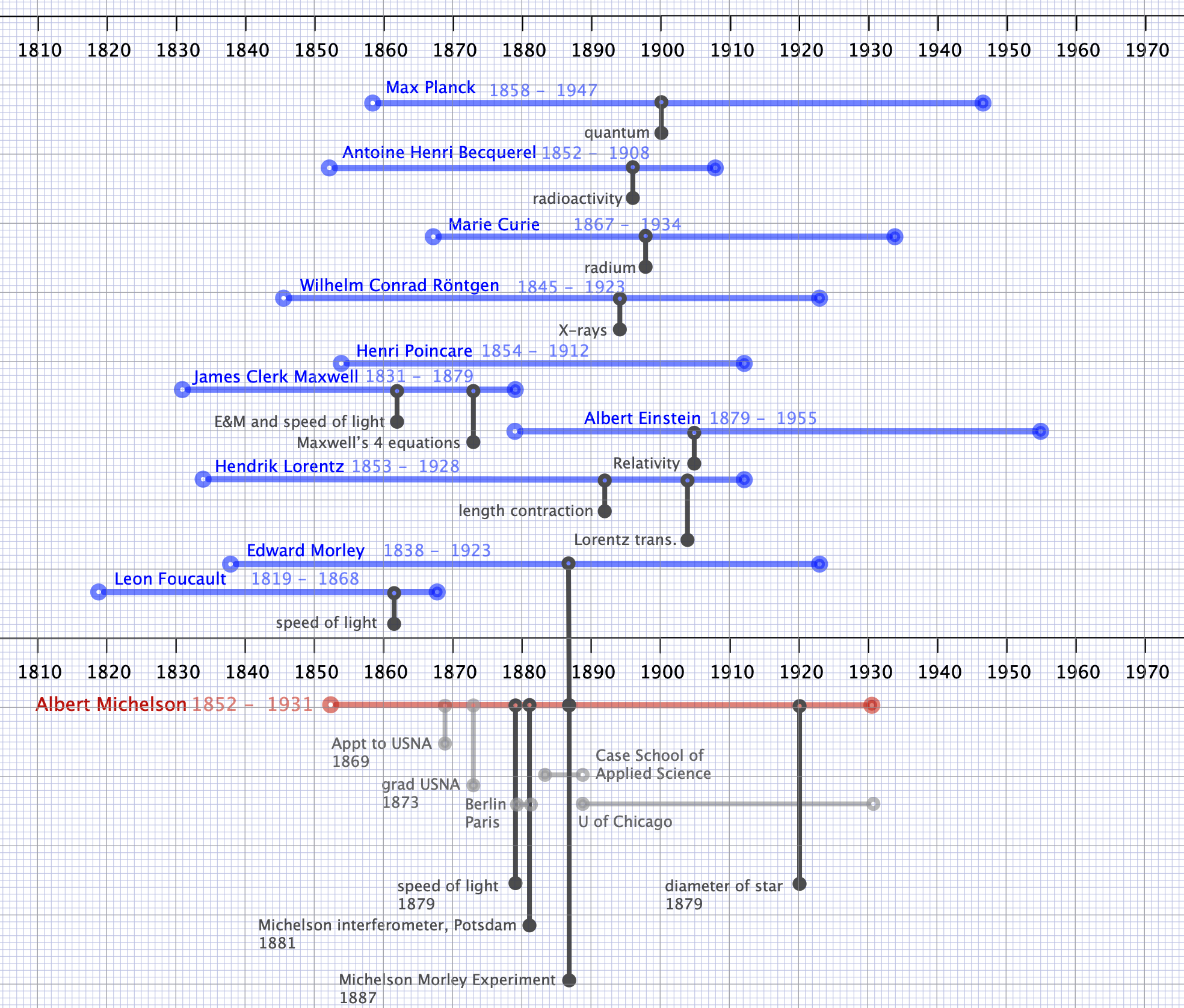
The Naval Academy
Today, in order to enter a U.S. service academy, one requires nomination by a state or federal elected representative. It's a highly competitive process requiring superior academics and typically, athletic background. Albert's growing interest in science had led to a favorably received paper on optics and he wanted to pursue this subject. But how?
The U.S. Naval Academy at Annapolis, Maryland was 20 years old when Albert graduated from high school and Samuel learned that Nevada's Congressman Thomas Fitch was accepting nominations for boys to the Academy. Albert applied, took the exams and tied with two other boys for first place. Fitch chose one of the other boys, who upon arrival failed and dropped out prompting Fitch to write to President Grant on his behalf. Albert didn't know of Fitch's letter and took matters into his own hands and did what his family did: he got on the road.
Those were different times. Albert traveled from Nevada to Washington D.C. on one of the first transcontinental trains and presented himself at the White House, met with Grant, and asked for a special appointment. The President is allotted 10 at large appointments (now the Vice President can nominate five) and Grant had used up that total. Not to be outdone, Albert then took himself to the Academy and sought an audience with the Commandant where he was examined, but told that there were no openings.
As Albert's daughter described later, he was literally getting on the train to return to San Francisco at Union Station when a messenger from the President intercepted him to say the the President had decided to appoint 11 midshipmen that year (and later two more, for a total of 13). Michelson always joked that he was probably illegally a student at the Naval Academy. But it worked out. In 1869, Albert joined the Navy.
Michelson graduated in 1873 at the top or near the top in experimental and mathematical subjects...and near the bottom in seamanship. He did his obligatory training at sea as an Ensign and eventually became an instructor at the Academy in 1875 and by 1877 was married to Margarett Hemingway, a daughter of a wealthy and powerful lawyer and investor in New York. After more cruises, Albert and Margarett had their first son in 1878.
Light
One of Albert's tasks was to create demonstrations for the midshipmen in their physics classes and he chose to take an old method for measuring the speed of light, a simple experiment done by physics students in hallways around the world to this day. Except he made it better and found a calling.
It's really fast
Was light an instantaneous disturbance? or did it travel at a finite velocity. Galileo imagined it to be the latter and tried to determine it between observers with lanterns on two Tuscan hilltops, but without any success. In the middle of the 17th century, Ole Roemer, a Danish astronomer, had the brilliant idea to use one of Galileo's moons of Jupiter as a clock. Io orbits Jupiter in about 42 hours and during that time, one can watch it disappear from view as it goes behind the planet. As shown in Figure X by timing one complete orbit of Io from eclipse to eclipse, Earth will have moved enough in its orbit to cause the path from Io's emergence to be different from the path when Io disappears. Further, if one measures the time of this motion at six month intervals, Earth would be moving away from Jupiter in one measurement and toward Jupiter on the other...so the difference between them would indicate that it took light a longer time (away) or a shorter time (toward) to reach Earth. Roemer's measurements were not quite precise enough to determine an actual speed, but later Christian Huygens did make a determination and found the speed of light to be 220,000,000 m/s. (Robert Hooke, the grumpy instrument maker and foe of Newton suggested that this speed was so high that one could just decide that light was instantaneous.)
The first terrestrial measurement of the speed of light waited until 1849 when Léon Foucault at the Paris Observatory created a clever apparatus shown in Figure X. He found m/s with a precision limited by the length of the path AB in the figure. This was the technique that Michelson adapted for his midshipmen students and by 1879, he'd improved on Fizeau's results by a factor of 20 finding m/s. (He later improved this to m/s in 1924.)
What's waving?
What's more ridiculous than a wave that has nothing to wave in? From the time of Aristotle, it was assumed that empty space was not empty, but consisted of a strange substance archaically called "aether" and in the 19th century, "ether." The persistent belief in this substance was reinforced in the 19th century when in sort order, Newton's insistence that light consisted of particles was enthroned by Thomas Young's (unwelcome) demonstration that light consisted of waves. Maxwell's unification of electricity, magnetism, and optics into a single model of waves of electric and magnetic field vectors and Hertz's demonstration of their existence made it clear: light was a wave and so it had to propagate in a substance which supported that disturbance. The ether was to light as air is to sound.
But this material was a very strange beast. If you were to do an experiment (that you should not do) involving a railroad track and a hammer, you would find that sound travels faster in a solid than in air. If your (former) friend bangs on a railroad track a 100 yards away, and if you put your ear to the track, you'll hear it through the metal before you hear it through the air. Now, get off the track.
The speed of a wave in a medium is dependent on the square root of the "stiffness" of the material–steel is a million times stiffer (the "bulk modulus") than air, so the speed of sound in steel would be 1000 times faster.
Now light is the fastest thing there is! So turning that argument around, the stiffness of the ether must be incredibly more than even steel. And yet, the ether needs to be easily plowed through by the planets that presumably swim around in their orbits through it. Reflecting their light to our telescopes. How can a substance offer no resistance to a planet's motion (or even a car, or a person, or a bird) and yet be incredibly more stiff than steel?
No matter. A detail. There had to be an ether in order for their to be a wave of light. The question is how do we "see" the ether? It seemed to have two functions, actually:
- Newton insisted that space was an absolute property of the universe and that there is an absolute coordinate system against which all motions–constant velocity and accelerated motions–could be measured. The ether seemed to be that perfect construct: it and only it would function as that absolutely at-rest structure that anchors space.
- And, even when Maxwell created his four equations for electricity and magnetism, out of which popped the mathematical representation of a transverse wave, the speed of that wave, "" was thought by him to be the speed of light relative to the ether, and so relative to Newton's absolute measuring stick.
What was known? Well, everyone knew that the ether was stationary and that the Earth moved through it. Everyone.
Stellar aberration
Germany
Always imaginative, during the last year of his life, James Clerk Maxwell suggested in a letter that it might be possible to measure the speed of the Earth relative to the (fixed) ether. An "in-principle" measurement that he thought would be practically impossible. But Michelson was now the king of optics and light and precision was his game. And he decided to take that on.
But. He was in the Navy and there was no graduate research program anywhere in the United States (Johns Hopkins University was thinking about it.) True to form, he took matters into his own hands and requested a leave of absence from active duty, talked his way into enrollment in the University of Berlin in Hermann von Helmholtz's laboratory, and off the young Michelson family went to Germany. And Paris..and for two years, rather than the one that he'd been granted.
Moving through the ether
His idea is easily understood with an analogy. A naval analogy.
Suppose you and your friend are standing by a river and ready to race. The river is still as shown in the figure and you each plan to pilot your motor boat a distance , starting at point and ending at point . One of you goes across the river (), and the other of you to the right and then left (). Who wins if both boats can move through the water at the same speed?
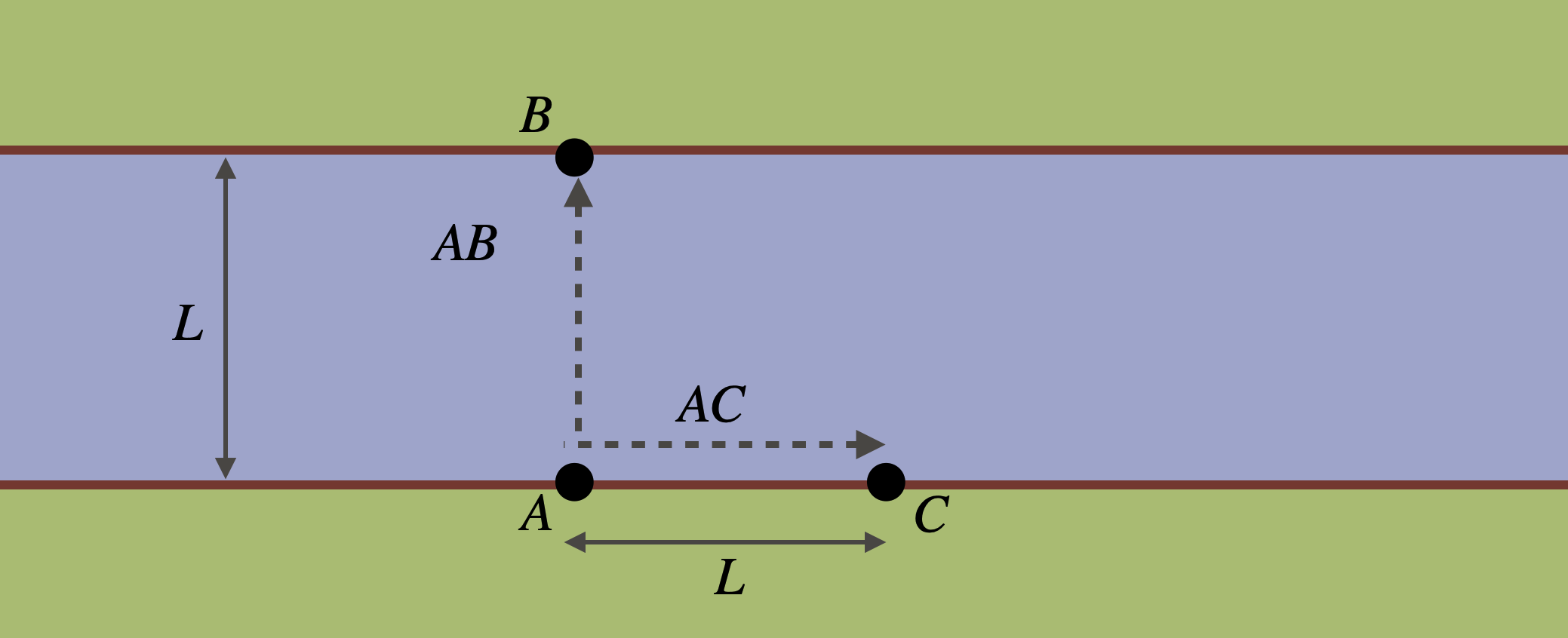
Obviously, both of you are traveling at the same speed, over the same distance and so your race from , compared with , would result in a tie. That's too easy.
Now suppose that the river has a strong current to the left. I take the right-left trip and in the first leg, I must go against the current while the return is helped by the current. By contrast, you take the trip but you can't go directly across the river since your boat would be carried downstream, so you must aim your boat to the right at just the right angle to drift to as you plow through the water at your regular speed. Then you return has to be the same thing.
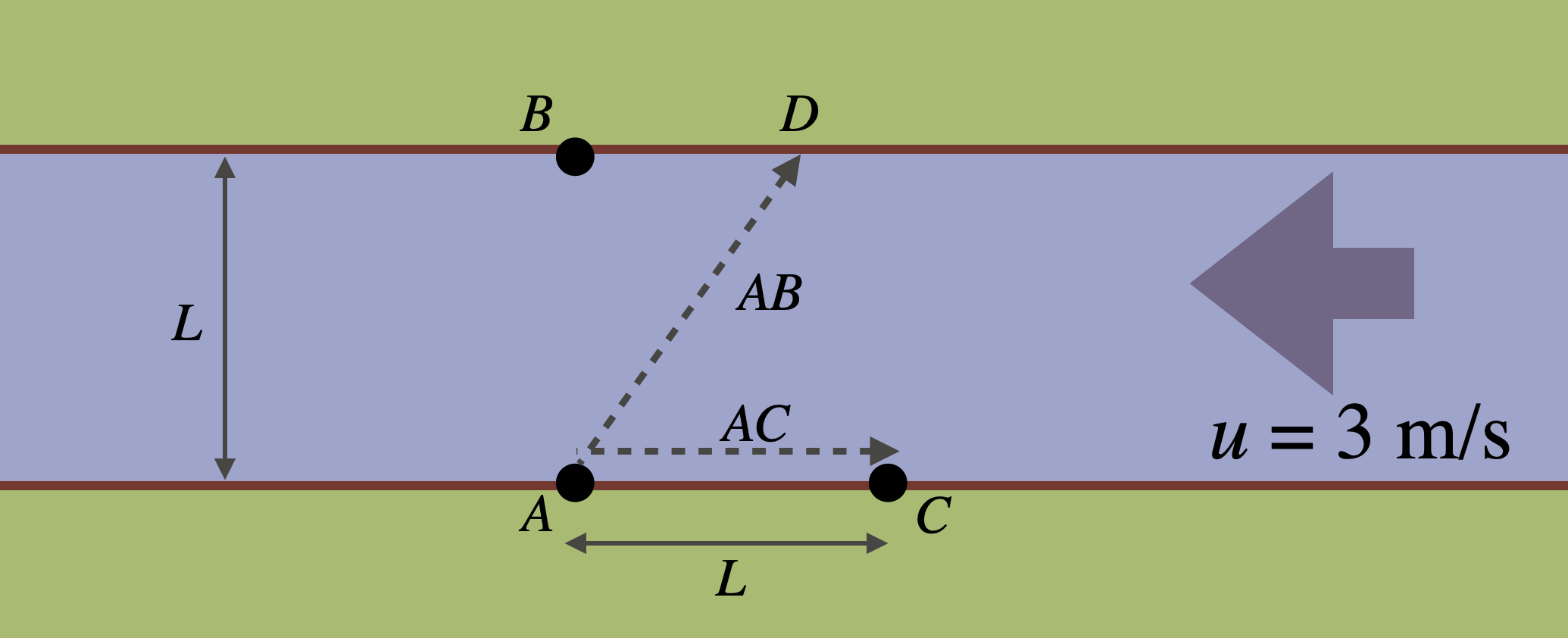
Who wins?
Well, it turns out that the round trip across the river will be quicker than the trip to the right and to the left. (The details are in the A Modern Bit of Michelson section below.
Now suppose we make the following substitutions in our nautical race:
- boat light beams
- river the ether "wind" as the Earth passes through it
- bank the Earth
From the position of the Earth, the ether moves past to the left as the Earth moves in its orbit, here to the right. So on Earth we should detect a constant "ether wind." Or a current.
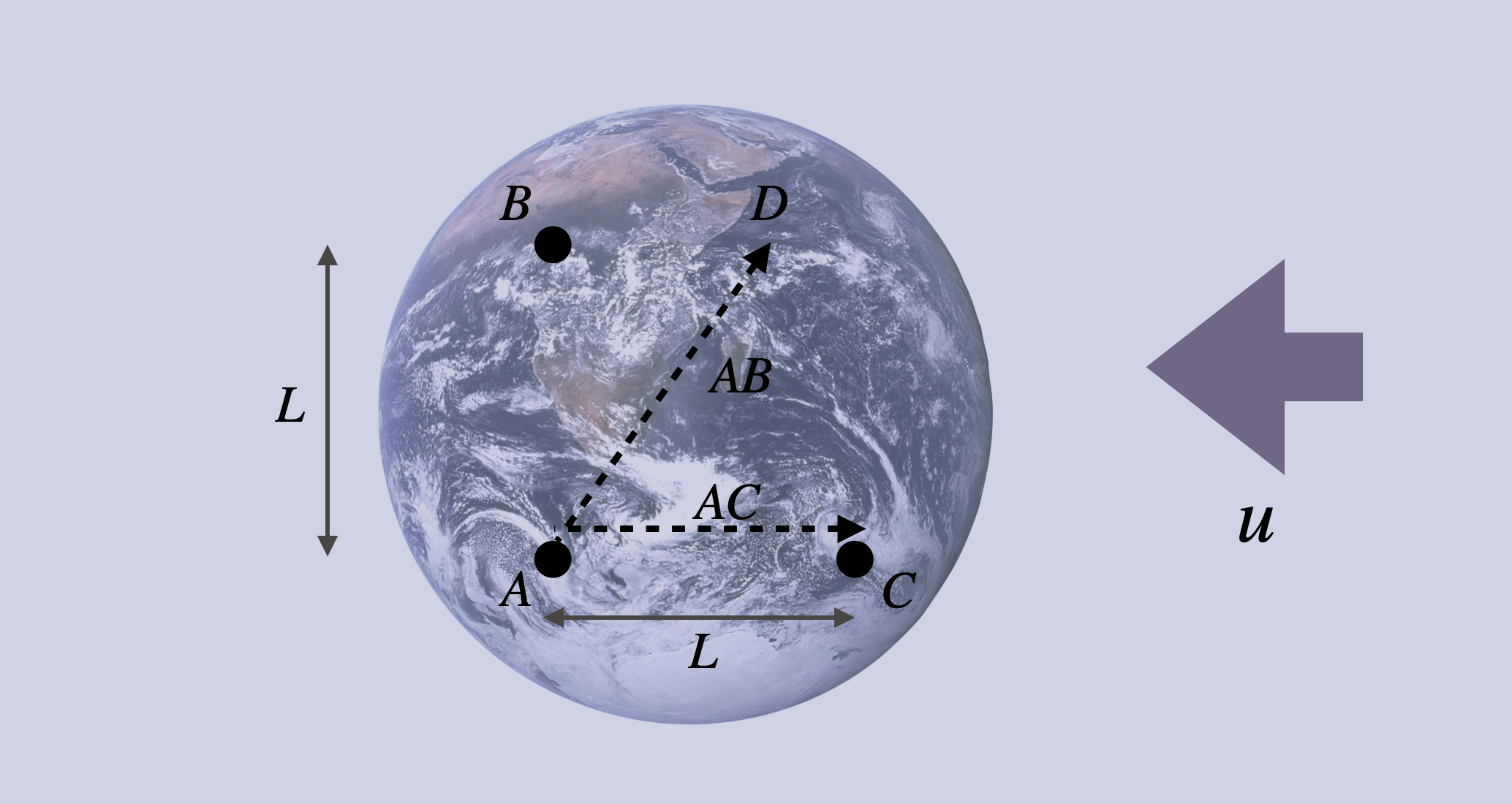
Michelson invented and built (on Earth!) a first version of an instrument that sent a beam of light in one direction, like and at the same time a second beam of light in a perpendicular direction, like . Then with mirrors he brought them together back at to see who wins. What determines winning? Well, light is a wave and when two waves encounter one another, they mix and interfere. Where the two waves are in-synch, the result is a new wave that's big at the position of the original common peaks. Where they're out of synch? Well, then you get a quiet result–no wave (think of your noise-cancelling headphones). If they're somewhere in-between, then there's a peak, but its not where the peak is for either of the two initial waves. So calibrate your instrument carefully for both beams in-synch and then turn it loose on the ether and see what happens.
With the phone guy's help
With financial assistance from Alexander Graham Bell and a German optical company, in 1881 Michelson built an exquisitely precise "Interferometer" which combined waves in exactly this way. (To see more about it, look below into A Modern Bit of Michelson.) Here are two drawings of his first prototype:

The top drawing is a view looking down on the interferometer. The points A, B, and C mean the same thing as on the river. The light enters from the left and is split in a half-silvered mirror at A and the two beams travel their seperate ways until they're brought back together at A.
The bottom drawing is a perspective view.
He knew how accurate his device needed to be because the effect of the two light beams would be of the order of
This required a ridiculous level of precision. His first instrument was not up to it as even traffic outside of the lab building was sufficiently disruptive to ruin his measurements. He subsequently moved it to Potsdam where the measurement was better, but unsatisfying. After more than six months of painstaking work, he published his progress and wrote to his benefactor:
Heidelberg, Baden, Germany
April 17th, 1881
My dear Mr. Bell,
The experiments concerning the relative motion of the earth with respect to the ether have just been brought to a successful termination. The result was however negative...
At this season of the year the supposed motion of the solar system coincides approximately with the motion of the earth around the sun, so that the effect to be oserve [observed] was at its maximum, and accordingly if the ether were at rest, the motion of the earth through it should produce a displacement of the interference fringes, of at least one tenth the distance between the fringes; a quantity easily measurable. The actual displacement was about one one hundredth, and this, assignable to the errors of experiment.
Thus the question is solved in the negative, showing that the ether in the vicinity of the earth is moving with the earth; a result in direct variance with the generally received theory of aberration...
N.B. Thanks for your pamphlet on the photophone.
The speed of the ether relative to the Earth is zero. It was the first failure that Michelson had endured in his so-far, distinguished career as the young King of Optics.
The fallout
There was very little reaction to Michelson's Potsdam experiment. Hendrik Lorentz–another "king," this time of electromagnetic, pointed out a numerical mistake in Michelson's analysis but it didn't change the result: still zero.
Hendrik Lorentz was revered by the entire physics community: the photograph suggests the kindly, wise man that everyone liked. He was the undisputed expert in the mathematics and physics of Maxwell's electromagnetism and extended it in a crucial way. Maxwell's equations describe the electric and magnetic fields due to extended charge distributions–"stuff" that you could hold in your hand.
Lorentz, however, was a firm believer in the atomistic picture and that the atoms included "electrons" which when they oscillated, radiated electromagnetic waves. In 1887 he worked out the equations for the motions of electrons and today we call these the Lorentz Force equations. His theory required that the motions of the electrons be related to the stationary coordinate system defined by the ether and so he was interested in Michelson's 1881 Potsdam results since they were inconsistent with his theory of electrons. Indeed, he criticized Michelson's conclusions in which he postulated that the ether was dragged by the Earth, and so no speed would be detected in his apparatus.
The Case School of Applied Science in Cleveland
When Michelson's time in Germany (and Paris) was done, he was unsure of his future and was delighted to discover that colleagues had interceded on his behalf at the brand new Case School of Applied Science in Cleveland, Ohio to offer him a faculty position. (This is now the very fine Case Western Reserve University.) With sufficient startup funds and laboratory space, Michelson readily accepted the position, resigned from the Navy, and in 1881 re-established his light-speed measurement work in Cleveland.
He never mentioned his 1881 Potsdam experiment in print or even in his classes but rather concentrated on improving the precision of his light-speed measurement as well as exploring whether different colors of light traveled at different speeds and repeating (with his characteristic precision) experiments that showed that the speed of light in water changed with the direction of the water flow. By this time in 1886 he and Edward Morley had found one another on a train returning from a conference in Montreal. Morley was a Case chemist and they'd simply not overlapped in Cleveland. They found common interests in science and in instrumentation and the water experiment was the first of their famous collaboration efforts.
This work exhausted him and he literally had a breakdown requiring hospitalization. In fact, his wife actually sought to have him committed (which added considerable tension to their relationship) and he spent months recovering in New York from serious emotional and mental incapacitation. Case actually replaced him on the faculty (!) as it was presumed that he'd never recover nor do science again. Luckily he recovered after a couple of months and returned to try to piece together his career and his marriage. The former recovered, but the latter was troubled for the next 13 years. Michelson moved himself into his own quarters in their large Cleveland house. By many accounts, his personality changed after these two betrayals and he became cynical about his relationships going forward. By the way, he was reinstated on the faculty...but told by the Board of Trustees that his salary would have to be cut in order to help pay for his (unnecessary) replacement.
In March of 1887, Michelson wrote to Lord Raleigh, the Dean of British science that the Potsdam experiment continues to bother him and that he and Morley were going to try to resurrect it. With Morley, what they created was a much different device.
Outside vibrations were reduced by building the whole thing on a huge, heavy sandstone slab that floated in a pool of mercury–a dangerous environment. This isolated it vibrationally and allowed the experimenters to keep the whole instrument in constant rotation, slowly so that the directions of the arms are constantly, uniformly changing. That would eliminate any potential bias. Furthermore with high quality mirrors the light paths were essentially increased to 36 meters in length which greatly improved the precision.
So on six days in July they did their experiment walking around the circle looking into the eyepiece all the while. In August, 1887, Michelson wrote to Raleigh:
The Experiments on relative motion of earth and ether have been completed and the result is decidedly negative. The expected deviation of the interference fringes from the zero should have been 0.40 of a fringe — the maximum displacement was 0.02 and the average much less than 0.01 — and then not in the right place.
As displacement is proportional to squares of the relative velocities it follows that if the ether does slip past [the earth] the relative velocity is less than one sixth of the earth’s velocity.
The result is unequivocally zero. For Michelson it's a failure. Either the ether moves with the Earth (which is contradicted by astronomical measurements: see A Modern Bit of Michelson) or there is no ether. Neither Michelson nor anyone could imagine that the ether didn't exist.
What now?
By 1888 Michelson was growing unhappy at Case. There was the on-again, off-again, strange replacement of Michelson's position. Furthermore, there was a huge fire on campus in 1886 that destroyed Michelson's laboratory forcing him to move into Morley's lab. The family had been through two more disasters in Cleveland. A cook actually robbed them of their jewelry and other valuables (which were recovered in Ravenna, Ohio). And, in 1887 a maid accused Michelson of sexual assault actually leading to his arrest with headlines in the paper! Blackmail was demanded and Michelson, Morley, a lawyer, and the Cleveland police actually set up a sting operation to get the perpetrator to expose her plot exonerating Michelson.
The lack of an ether would seem to pale compared to these events, but it didn't.
When a Clark University was started in Worcester, Massachusetts, Michelson jumped at the chance to restart his program as the first Chair of Physics with finally adequate financial and technical support. Case had really blown it. Off they went to the countryside. It wasn't a match made in heaven for any of the faculty recruited to Clark. By 1892, he and almost all of the faculty resigned because of an unbearable central meddling by the university president who was on an entirely different course from the founder and financial benefactor, Jonas Clark. It was a mess. Today, Clark University is a thriving institution. But another one bearing the distinction of losing Michelson. To the new University of Chicago.
A Modern Bit of Michelson
How was the speed of light measured?
Is the ether stationary or does it move with the Earth?
Michelson's Interferometer
The analysis of the boat race is straightforward.
The measurement in the river
In our scenario:
- the river is 100 m wide and so .
- Each boat is capable of 5 m/s.
- There are two scenarios: the still river where and the moving current in which m/s.
Here is the still river scenario.

If the speed is m/s then the time that it takes to travel a distance, is seconds. The round trip for the vertical boat is then 40 seconds. And trips to the left and to the right are identical to each other and to the vertical trip. So both boats return to A at the same time.
Now suppose that the river has a strong current of m/s to the left.

If the goal is to leave from and return to then a strategy is required of the vertical boat, right? Since striking out directly across would cause a drift with the current to the left. So the smart boat-captain would aim against the current allowing for the current's drift to the left. By choosing the angle correctly, by the time that boat gets across it will reach B. In this contrived example, that angle corresponds to a triangle, in which the arm to the left, would be 75 m and the hypotenuse, would be 125 m. The time for the vertical boat to get to through the route would be 25 seconds. The return to is the same, so the round trip is seconds.
Meanwhile, the horizontal boat must travel against the current and so the speed relative to the bank would be m/s. Coming back, the current helps and the speed is m/s. So the two times are seconds and seconds for a round trip time of $62.5% seconds. The details can be found below in the "Modern Bit."
The vertical trip wins.
The measurement in the ether